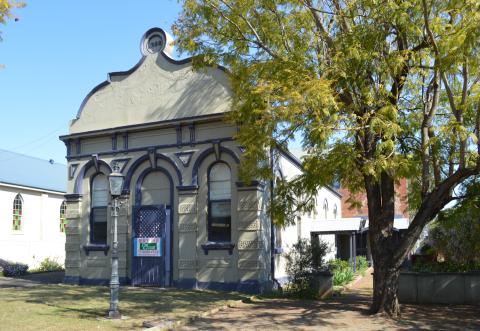The Scone School of Arts was a Mechanics' Institute that provided adult education in the town of Scone, New South Wales, Australia in the late 19th and early 20th century. The School, founded in 1868, occupied two heritage listed buildings in Scone – the first from 1873 to 1917, the second from 1924 until the School's closure in 1954.
...
In January 1871, the School began to raise funds for a building, for which plans were approved in July 1871. A site (91 Kingdon Street) between the town's Presbyterian church and the railway line, was purchased for £11. The proposed hall measured 50 ft by 25 ft, with a stage and two skillion rooms, and was to be of brick construction with a shingle roof. The 50,000 bricks required for construction were locally produced by a John Newman at £2 per 1000 bricks, and construction began in late 1872. The building officially opened on 9 September 1873. In September 1873, The Maitland Mercury and Hunter River Advertiser described it as having "a handsome stuccoed front, of the Tuscan order ... built of brick on a stone foundation, and is roofed with galvanised iron."
This building, now incorporating the local library, with 1359 books, was later (1887–1889) extended to include a new stage, proscenium, reading room, library, ante-room and porch. It hosted a variety of activities, meetings and events, including lectures. Notable speakers included Mark Twain (on 19 December 1895), who gave a talk on 'morals' which, according to the Scone Advocate, was punctuated with "droll sayings and humour," and Banjo Patterson in 1900.
During the 1890s and 1900s many exhibitions and competitions were held at the school, including needlework, drawing, mapping, writing, spelling bees, elocutionary and music contests. In 1890, it opened a gym (which closed soon after). Membership peaked at 192 in 1906. By July 1908, it started to hold classes including dress-making, cutting and millinery with instructors coming from Sydney Technical College. The School of Arts established drama and musical clubs, and had a billiards table.
It was also used as a drill hall during World War I, having been compulsorily acquired by the Department of Defence for £850 in 1917. The building later reopened as a dance school, a pop-up shop, and as bed and breakfast accommodation, called Willowgate Hall.
